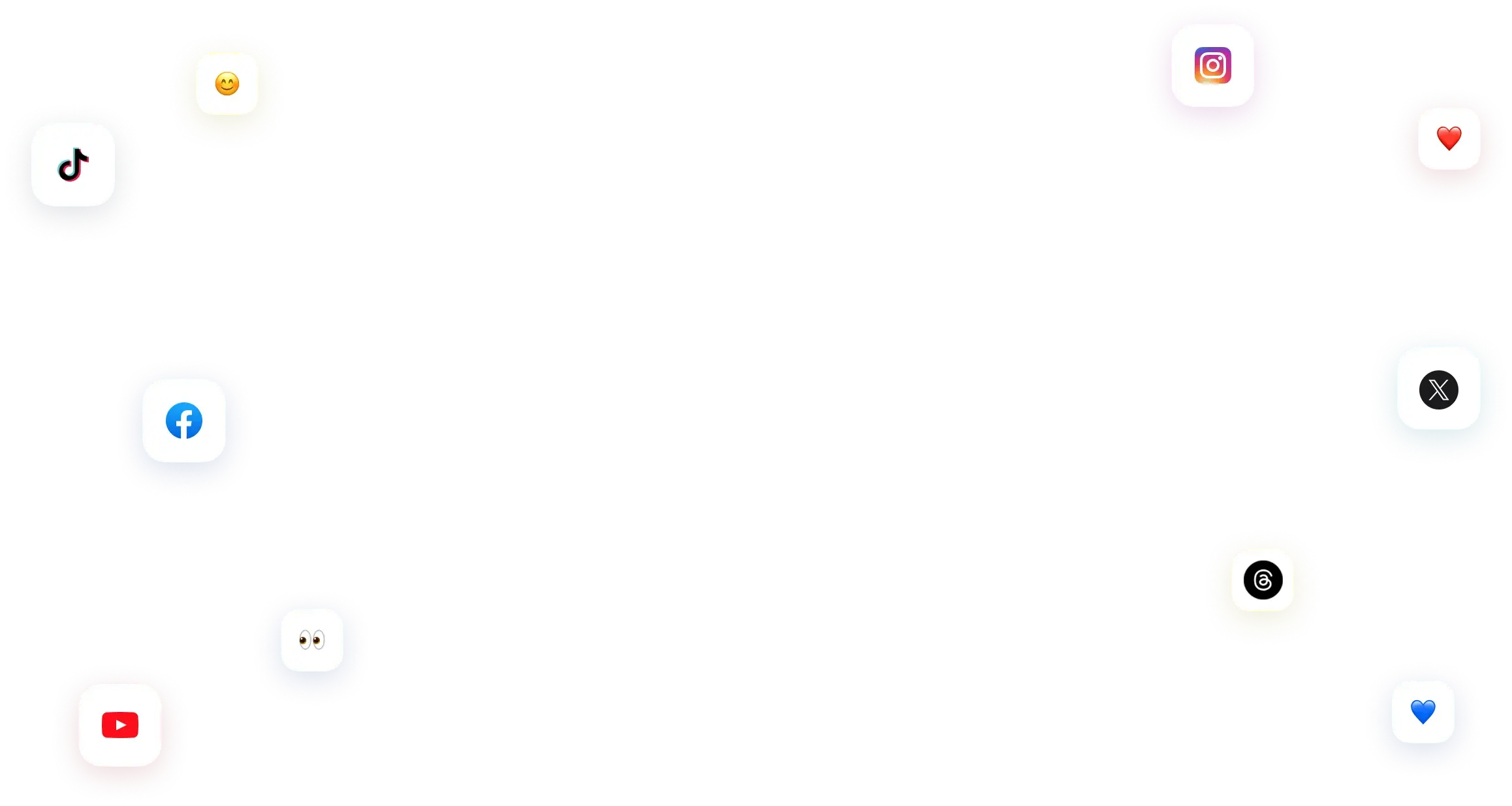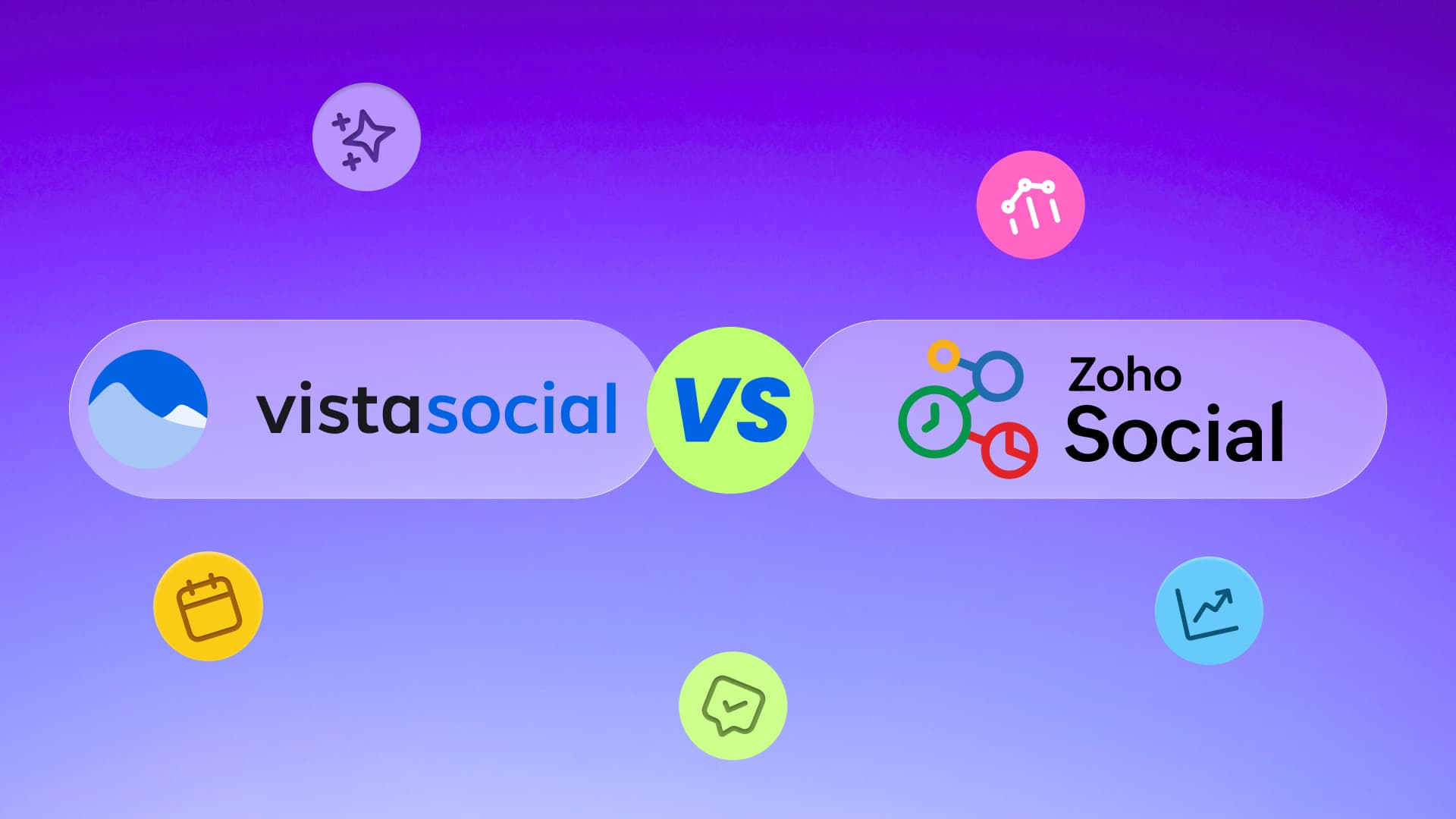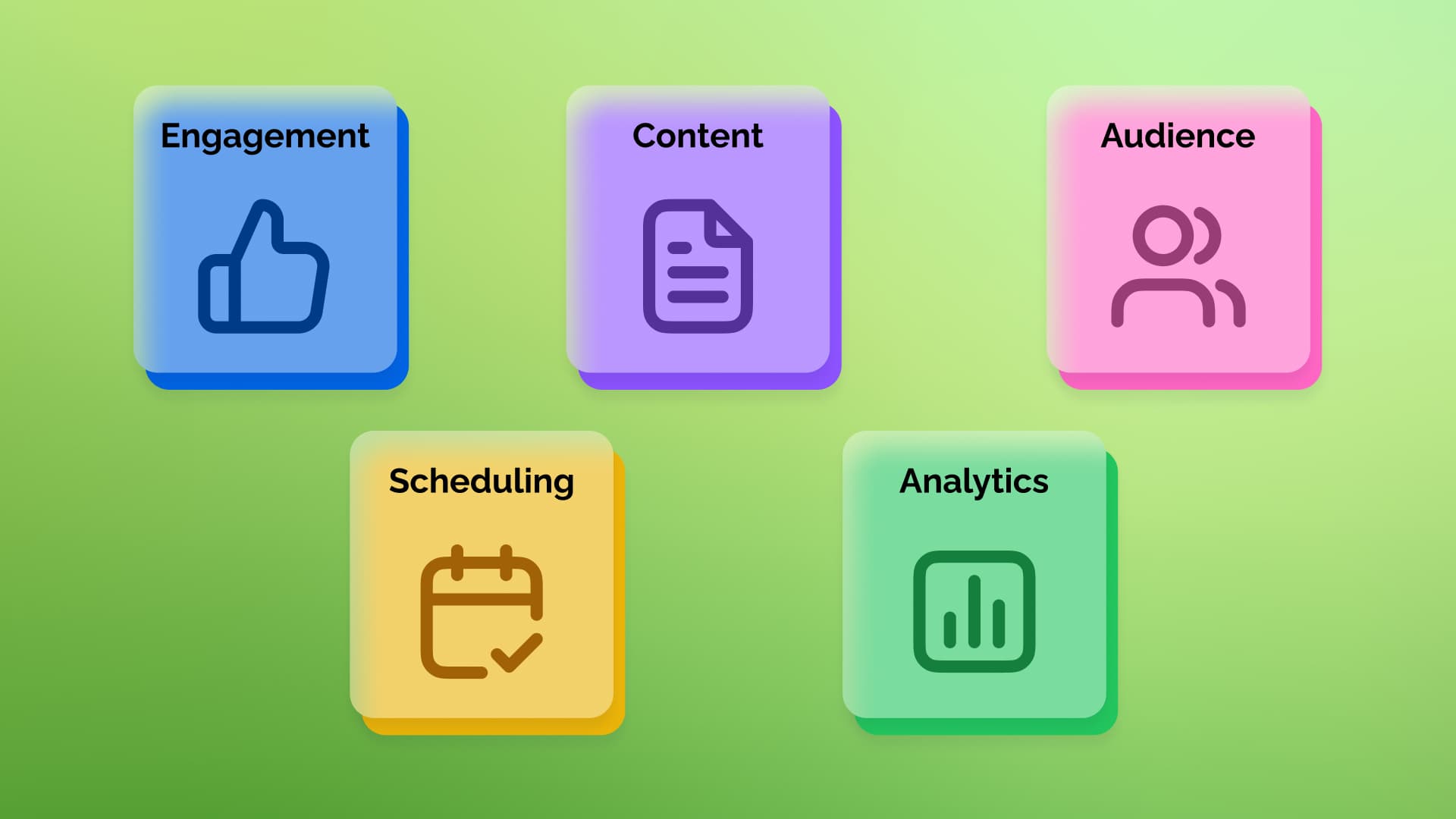New

Turn Your DMs Into Lead Gen!
Learn how to collect lead data from your DMs such as email addresses, phone numbers, and more right from your social inbox. If you are not yet automating your DMs your competitors are outpacing you.

How Something Social Saved 75% of Their Time and Increased Revenue by 15%
See how a fast-growing agency improved operations, cut down hours of manual work, and unlocked new revenue opportunities with Vista Social.
New

50 Unique Social Media Ideas for Consistent Content Creation
Discover 50 unique social media post ideas to engage your audience, grow your brand, and maintain a consistent content strategy with ease!

Mastering Content Reuse: The Key to a Consistent and Sustainable Posting Strategy
Published on September 29, 2025
14 min to read
13 Essential Social Media Manager Skills to Succeed in Your Career
Summarize with AI


Table of Content

Did you know that 5.24 billion people in the world are social media users? That’s 63.9% of the entire global population. So it should come as no surprise that businesses need social media managers to help them reach those 5.24 billion people.
In fact, the U.S. Bureau of Labor Statistics estimates this career path will grow by 6% over the next 10 years. As demand grows, developing strong social media manager skills is more important than ever for those looking to thrive in this career.
So, what does a social media manager really do? At its core, the role involves planning, creating, posting, and monitoring content across a brand’s platforms, all to increase visibility and engagement. But the responsibilities don’t stop there.
Social media manager skills have evolved far beyond simply posting content. Managers now need to combine strategy, creativity, and technology to stay competitive.
From analytics and data-driven insights to community building, influencer outreach, and even AI-powered workflows, the modern social media manager wears many hats. Thriving in this competitive space requires professionals to build a strong foundation of social media manager skills that balance creativity with technical expertise.
In this article, we’ll walk through the most essential social media manager skills that need to be mastered in 2025 and beyond.
Table of contents
What does a social media manager do?
A social media manager is the professional responsible for developing, executing, and overseeing a brand’s presence across social platforms.
Their role goes far beyond simply posting content; they craft strategies that align with business goals, engage with communities, monitor performance, and adapt to the ever-changing digital landscape.
Modern social media managers are strategists, creators, analysts, and community builders all in one.
They carefully plan campaigns and content launches, ensuring that every post has a clear purpose. They maximize impact by tailoring messaging to the right audience, timing content to ride trends at the perfect moment, and preparing crisis management strategies to protect the brand’s reputation when challenges arise.
But these responsibilities are only the tip of the iceberg.
A great social media manager must also analyze data to refine strategies, build authentic relationships with followers, collaborate with influencers, and adapt to the rapid pace of technological change, especially with AI and automation now shaping workflows.
At their core, social media managers oversee multiple platforms and moving parts, ensuring that all efforts contribute to long-term business growth.
13 skills every social media manager needs
Here are 13 social media manager skills that are highly valuable for every social media manager.
1. Strategic thinking and planning
Strategic thinking and planning are the ability to look at the bigger picture and connect day-to-day social media actions to long-term business goals. It’s about anticipating challenges, identifying opportunities, and creating a roadmap that ensures every campaign serves a purpose.
Why it matters: Strategy is everything; it is the foundation that guides everything else. Without a strategy, even strong execution (like content creation, analytics, or engagement) can end up unfocused and ineffective.
Key skill: The ability to align social media campaigns with overall business objectives, while also balancing short-term engagement goals with long-term brand building. A strong strategist understands both the platform-specific nuances and how those efforts roll up into revenue, awareness, or customer loyalty.
Examples of strategic thinking and planning in action:
- Creating quarterly content calendars built on data insights to maximize reach and engagement
- Analyzing competitor activity to spot gaps and opportunities in the market
- Planning campaigns around product launches, seasonal events, or cultural moments
- Using analytics to decide which platforms deserve the most investment
- Setting SMART goals for campaigns and measuring against them consistently
2. Content creation and storytelling
Content creation is the backbone of a brand’s presence. Think of it as the weapons manufacturing of your army, the content itself becomes the ammunition you deploy. Whether it’s posts, videos, blogs, or even memes, everything your audience sees falls under content creation.
But content alone isn’t enough. When combined with storytelling, those weapons are no longer generic; they’re tailored for the specific battle you’re fighting. Storytelling shapes raw content into impactful messages, making your campaigns resonate deeply with audiences instead of feeling like random, disconnected posts.
Why it matters: A brand without content is a brand without a voice. Content creation allows businesses to share their message across platforms—through Reels, Stories, TikToks, and more. When paired with adaptive storytelling, it makes the brand flexible and better positioned to expand its reach.
Key skill: Crafting engaging posts while adapting storytelling to each platform’s unique audience, aiming to stay creative while keeping the brand’s voice consistent across channels.
Examples of content creation and storytelling:
- On Instagram Reels and TikTok, managers can use trending formats to boost reach while keeping the brand’s core message clear
- On LinkedIn, storytelling might focus on thought-leadership posts that build authority and credibility
- On Instagram Stories, behind-the-scenes content, polls, or Q&A sessions help strengthen authenticity and engagement
- With memes or pop culture references, managers can inject humor and relatability without straying from brand identity
3. Copywriting and communication
Copywriting is the voice of your campaigns. It’s the words that persuade, motivate, and trigger action the battle cry that rallies your audience in the vast digital battlefield.
Effective copywriting transforms a simple post into a message that drives clicks, sign-ups, or sales. It gives campaigns their emotional impact, ensuring that content doesn’t just get seen but inspires the audience to act, ultimately boosting conversions and ROI.
Why it matters: Even the most eye-catching post won’t convert without the right words. Copywriting turns attention into action—guiding leads toward conversion and boosting ROI. Strong copy also ensures your tone of voice aligns perfectly with your target audience, building trust and engagement.
Key skill: Strong social media manager skills include writing captions, CTAs, and ad copy that don’t just look good but actually convert. Good copywriting aligns tone of voice with audience expectations, creating trust while motivating action.
Examples of copywriting and communication:
- A persuasive copy style can be used in ads to encourage immediate action, such as clicking “Shop Now” or “Sign Up”
- A conversational tone works well in captions, making the brand feel approachable and relatable
- An educational style is effective in longer posts or threads, helping to provide value while building authority and credibility
For instance, L’Oréal used clever copywriting to spark conversation with the line “This is an ad for men. Hire more women in leadership roles. We’re all worth it.” Paired with an image of lipsticks, the ad stood out by combining a bold social message with product placement—an example of copy that goes beyond selling to build brand identity and values.
4. Graphic design and video editing
Along with strong copywriting, skills in graphic design and video editing elevate your content creation. Visuals are often the first thing audiences notice, making design and editing essential to shaping your brand’s identity.
These skills allow you to control how your brand is presented, build recognition, and stand out from competitors with unique, engaging content.
Why it matters: Social media these days is visual-first. Eye-catching graphics and videos capture attention faster than text alone, making them essential for engagement. While social media managers don’t need to be professional designers, knowing the basics helps them produce polished, scroll-stopping content.
Key skill: Using tools like Canva, CapCut, or Adobe Express to create and edit visuals quickly and effectively.
Examples of graphic designs and video editing:
- Designing scroll-stopping social media graphics that instantly communicate your message
- Editing short-form videos (like Reels or TikToks) that boost engagement and shareability
- Maintaining consistent brand colors, fonts, and style across all content for stronger recognition
- Using visual storytelling in videos to explain complex ideas in a simple, engaging way
Colgate took a lighthearted approach by posting a rough sketch of a toothpaste tube with the caption, “Our graphic designer is out today, please buy our toothpaste.” The tongue-in-cheek post stood out for its humor, showing that a brand doesn’t always need polished visuals to spark attention. By poking fun at itself, Colgate came across as more relatable while still driving strong engagement.
5. Data analysis and social media analytics
Just like an intel division studies the battlefield to guide generals, data analysis helps social media managers read the digital landscape. By tracking engagement, reach, and audience behavior, managers can spot opportunities, adjust strategies, and avoid mistakes.
Why it matters: Analytics reveal whether your strategy is driving growth or falling short. By interpreting KPIs such as engagement, reach, CTR, and ROI, social media managers can understand performance trends and pinpoint where adjustments are needed. This transforms raw data into insights that fuel smarter decisions and continuous growth.
Key skill: Interpreting KPIs and using tools like Vista Social for real-time insights.
Example of data analysis and social media analytics:
- Tracking top-performing content: Like intel spotting successful missions to repeat
- Refining audience targeting: Similar to mapping positions to hit the right audience
- Optimizing posting times: Just as intel guides attack timing, it boosts engagement
6. Community management and engagement
Community management is the heart of social media manager skills—it’s what keeps your audience connected to your brand. Just like maintaining morale in an army, consistent interaction with your followers builds loyalty, trust, and long-term support.
Why it matters: Your audience is your renewable energy that keeps your brand running; without them, your brand falls down. Building a sense of community through engaging with them is a simple way to keep that energy flowing, a quick response to their comments, DMs, and mentions makes a difference in your relationship with your audience.
Key skill: Engaging with audiences through timely responses and authentic interactions.
Example of community management and engagement:
- Replying within minutes to a customer’s concern and resolving it before it escalates
- Hosting Q&A sessions or polls to spark conversations
- Turning a negative review into a positive story by addressing the issue quickly and publicly
7. Paid advertising
Paid ads are the wild card of your brand. They give you the ability to boost audience reach and target people who align with your brand’s message. Unlike organic growth, paid campaigns deliver faster and more controlled results—much like a precision airstrike that hits exactly where it’s needed.
Why it matters: Great content and copywriting set the foundation, but paid advertising takes reach to the next level. By targeting audiences who already match your brand’s niche, ads deliver faster results and stronger ROI. Platforms like Facebook Ads Manager, TikTok Ads, and LinkedIn Ads give social media managers the tools to expand reach with precision.
Key skill: Allocating funds wisely and running A/B tests to find out which ad creatives, copy, and audiences perform best.
Try Vista Social for Free
A social media management platform that actually helps you grow with easy-to-use content planning, scheduling, engagement and analytics tools.
Get Started NowExamples of paid advertising:
- Running a TikTok ad campaign to launch a new product and targeting Gen Z users with trending sounds
- Using LinkedIn Ads to reach decision-makers in B2B industries for lead generation
- A/B testing two different ad creatives on Facebook to see which drives more clicks and conversions
This Lightroom ad is a straightforward example of how brands use paid campaigns to highlight product features and drive conversions.
8. Influencer outreach and collaboration
Influencers are like trusted allies on the battlefield—having them on your side can expand your brand’s reach far beyond what you could achieve alone. By identifying and partnering with the right creators, social media managers tap into ready-made audiences that already trust their “ally.”
Why it matters: Influencers can amplify your brand’s reach and build trust with audiences faster than traditional marketing. Choosing the right partners ensures your message is authentic and resonates with their followers. Effective collaboration not only boosts visibility but also drives measurable results.
Key skill: Identifying and vetting influencers, then negotiating collaborations with clear expectations.
Example of influencer and collaboration:
- Partnering with a micro-influencer to boost engagement in niche communities
- Running co-branded campaigns with clear expectations and deliverables
- Tracking ROI to measure the real impact of influencer partnerships
9. Project management and organization
A skilled general doesn’t just plan battles—they coordinate troops, resources, and timing to ensure everything runs smoothly. The same goes for social media managers, who juggle multiple accounts, campaigns, and deadlines at once. Strong project management ensures nothing slips through the cracks, while keeping the team aligned and productive.
Why it matters: Social media managers juggle multiple platforms, campaigns, and deadlines at once. Strong organizational skills ensure nothing falls through the cracks and every project runs smoothly. Effective project management also makes collaboration with designers, copywriters, and marketers more efficient.
Key skill: Managing multiple accounts and campaigns with tools like Asana, Trello, or Vista Social’s shared calendars.
Examples of project management:
- Using tools like Asana, Trello, or Vista Social’s shared calendars to track deadlines
- Coordinating with designers, copywriters, and marketers to keep campaigns cohesive
- Prioritizing urgent tasks while balancing long-term strategies to avoid burnout
10. Adaptability and trendspotting
The digital battlefield is never constant—it shifts daily with new trends, features, and audience behaviors. The most adaptable leaders are the ones who stay ahead. For social media managers, adaptability means being flexible with strategies, adjusting when needed, and spotting trends before competitors do.
This skill allows brands to capitalize on viral moments, experiment with new formats, and keep their content fresh and relevant.
Why it matters: Social media evolves daily, and adaptability is what keeps brands relevant. From trending memes to new platform features, being quick to adjust allows managers to stay ahead of the competition. Experimenting with emerging formats like AI-generated content, VR, or AR helps uncover what resonates most with audiences.
Key skill: Spotting and acting fast on trends across platforms while staying flexible with strategy.
Examples of adaptability and trendspotting:
- Jumping on trending TikTok sounds to boost organic reach
- Leveraging new features (like Instagram Threads or Reels) before competitors
- Testing emerging formats such as AI visuals, VR product demos, or AR filters
11. Crisis management and problem-solving
Even the best battle plans can face sudden ambushes, and the same is true on social media. A skilled social media manager knows how to manage a crisis—responding quickly and professionally when issues arise, whether it’s customer complaints, viral backlash, or unexpected PR crises.
Why it matters: Problems are inevitable, no matter how refined your strategy may be. What matters most is how you respond. Addressing issues from your audience or customers quickly and with a carefully thought-out approach can prevent them from escalating into bigger crises. Strong crisis management protects both brand reputation and customer trust.
Key skill: Knowing how to respond during PR crises or viral backlash, and creating clear escalation protocols.
Examples of crisis management and problem-solving:
- Addressing negative feedback with empathy to de-escalate conflict
- Following escalation steps for managing viral backlash
- Applying quick-response tactics that protect and even strengthen brand reputation
12. AI and automation
In modern warfare, technology gives armies the edge—and in the digital battlefield, AI plays that role for social media managers. AI and automation streamline repetitive tasks like scheduling, reporting, and even drafting copy, allowing managers to focus on strategy and creativity.
But true skill lies in knowing what to automate and what still needs the human touch—like community engagement and authentic storytelling.
Why it matters: Artificial Intelligence is rapidly transforming social media management. From scheduling posts to generating captions and analyzing performance, AI tools make managing campaigns faster and more efficient. However, knowing what to automate—and what still requires a human touch—is essential for maintaining authenticity and brand voice.
Key skill: Leveraging AI for scheduling, copywriting, and analytics while balancing automation with human creativity.
Examples of AI and automation:
- Using Vista Social’s AI Assistant to generate captions and performance reports that save time without sacrificing quality
- Using AI tools to auto-schedule content across multiple platforms
- Leveraging AI assistants for caption generation or performance reporting
- Automating routine tasks while keeping customer interactions personal
13. Mastery of social media marketing tools
Every great general relies on the right weapons and intelligence systems—and for social media managers, that means mastering their tools. From scheduling and publishing to social listening, reporting, and collaboration, these platforms streamline workflows, save time, and keep campaigns consistent.
Why it matters: Managing social media manually is no longer practical. The right tools streamline workflows, ensure consistency, and save time. By mastering them, managers can focus on strategy and creativity while improving collaboration and making smarter, data-driven decisions—giving brands a competitive edge.
Key skill: Learning to navigate and optimize social media management tools effectively.
Vista Social is designed as a complete solution for managers, agencies, and businesses—streamlining daily workflows while enhancing collaboration and results. With everything in one platform, it becomes easier to stay consistent, data-driven, and ahead of the competition.
With Vista Social, you can schedule posts across platforms, generate captions with AI, monitor brand mentions, track performance through analytics, and collaborate seamlessly with teams and clients—all in one platform.
Bonus: Essential soft skills for social media managers
Social media manager skills go beyond technical skills; social media managers also require personal qualities that resonate with what they do to excel in this fast-paced environment. These traits not only make the difference between simply managing accounts and truly leading a brand’s digital presence.
- Creativity: The ability to think outside the box and bring fresh, original ideas to life is the hallmark of true creativity. Whether it’s brainstorming unique content concepts or finding innovative ways to tell stories across platforms, creativity helps capture attention and makes a brand stand out in today’s crowded digital space.
- Empathy: Social media is all about connection. Empathy allows managers to understand their audience’s needs, emotions, and perspectives. By putting themselves in their followers’ shoes, managers can craft content that resonates on a deeper level and build authentic relationships.
- Leadership: Leadership goes far beyond simply managing tasks. A social media manager often works at the intersection of multiple teams—designers, copywriters, marketers, and clients. Strong leadership ensures campaigns move forward smoothly, goals remain clear, and every team member feels guided, supported, and motivated to deliver their best work.
- Time management: Time is one of the most valuable resources, especially when leading a team focused on delivering ROI for a brand. Managing multiple accounts, campaigns, and deadlines requires exceptional organization. Great managers know how to prioritize tasks, balance urgent demands with long-term strategy, and consistently deliver high-quality work without burning out.
Building the right social media manager skills in 2025
In 2025, social media manager skills go far beyond simply posting content. To truly thrive in this fast-paced digital environment, managers need a powerful mix of creativity, analytical thinking, adaptability, and technological expertise.
Creativity fuels storytelling that captures attention, while analytics reveal what’s working and what needs improvement. Adaptability keeps brands ahead of trends and shifting algorithms, and tech know-how—especially with AI and automation—empowers managers to streamline processes and scale results.
For anyone looking to grow in this career, the key is to continuously build these skills while leveraging the right tools. Platforms like Vista Social help save valuable time, automate repetitive tasks, track performance, and simplify collaboration—all while keeping campaigns consistent and effective.
P.S. New here? Vista Social is an all-in-one social media management platform built for agencies, freelancers, and social media managers. With advanced features designed to boost collaboration, streamline workflows, and maximize results, it’s the perfect tool to take your strategy to the next level.
Start your free Vista Social account today and see how it can transform your social media management.
Social media manager skills FAQs
What skills are most in demand for social media managers in 2025?
The most in-demand skills include strategic thinking, content creation, copywriting, analytics, adaptability, and AI proficiency. Employers and clients are looking for managers who can balance creativity with data-driven decision-making while staying ahead of emerging trends.
How long does it take to develop strong social media management skills?
It depends on the person and where you are starting from. With consistent practice, many managers can build a solid foundation within 6–12 months, especially if they’re actively managing accounts, running campaigns, and learning from analytics. Mastery, however, comes with experience—often 2+ years of hands-on work. The pace of growth depends not only on experience but also on your dedication to improving every day.
What tools and resources can help me improve my social media manager skills faster?
Using all-in-one platforms like Vista Social accelerates growth by simplifying scheduling, reporting, social listening, and AI content creation. Pair this with ongoing learning through blogs, podcasts, webinars, and case studies to stay updated with industry best practices.
Is AI replacing social media managers in 2025?
No—AI isn’t replacing social media managers, but it is transforming how they work. AI tools handle repetitive tasks like scheduling, analytics reporting, and even content drafting. This frees managers to focus on strategy, creativity, and relationship building—areas where human insight is still irreplaceable.
What certifications or courses can help build these skills?
Certifications from platforms like Meta Blueprint, Google Analytics, HubSpot, and Hootsuite can strengthen credibility. Online learning sites such as Coursera, LinkedIn Learning, and Udemy also offer courses in social media strategy, advertising, and copywriting that help sharpen skills quickly. Don’t overlook free learning on YouTube, where countless creators share up-to-date social media strategies and tutorials.
About the Author
Content Writer
Content writer and copywriter with over 2 years of experience, specializing in VSL scriptwriting. I’ve worked with various brands to create compelling content. Passionate about storytelling that connects and converts. Loves cats, poetry, and skincare
Read with AI
Save time reading this article using your favorite AI tool
Summarize with AI
Never Miss a Trend
Our newsletter is packed with the hottest posts and latest news in social media.

You have many things to do.
Let us help you with social media.
Use our free plan to build momentum for your social media presence.
Or skip ahead and try our paid plan to scale your social media efforts.
P.S. It will be a piece of cake 🍰 with Vista Social
Subscribe to our Newsletter!
To stay updated on the latest and greatest Social Media news. We promise not to spam you!





